The SNF1-type serine-threonine protein kinase SAPK4 regulates stress-responsive gene expression in rice
- PMID: 18442365
- PMCID: PMC2386468
- DOI: 10.1186/1471-2229-8-49
The SNF1-type serine-threonine protein kinase SAPK4 regulates stress-responsive gene expression in rice
Abstract
Background: Plants respond to extracellularly perceived abiotic stresses such as low temperature, drought, and salinity by activation of complex intracellular signaling cascades that regulate acclimatory biochemical and physiological changes. Protein kinases are major signal transduction factors that have a central role in mediating acclimation to environmental changes in eukaryotic organisms. In this study, we characterized the function of the sucrose nonfermenting 1-related protein kinase2 (SnRK2) SAPK4 in the salt stress response of rice.
Results: Translational fusion of SAPK4 with the green fluorescent protein (GFP) showed subcellular localization in cytoplasm and nucleus. To examine the role of SAPK4 in salt tolerance we generated transgenic rice plants with over-expression of rice SAPK4 under control of the CaMV-35S promoter. Induced expression of SAPK4 resulted in improved germination, growth and development under salt stress both in seedlings and mature plants. In response to salt stress, the SAPK4-overexpressing rice accumulated less Na+ and Cl- and showed improved photosynthesis. SAPK4-regulated genes with functions in ion homeostasis and oxidative stress response were identified: the vacuolar H+-ATPase, the Na+/H+ antiporter NHX1, the Cl- channel OsCLC1 and a catalase.
Conclusion: Our results show that SAPK4 regulates ion homeostasis and growth and development under salinity and suggest function of SAPK4 as a regulatory factor in plant salt stress acclimation. Identification of signaling elements involved in stress adaptation in plants presents a powerful approach to identify transcriptional activators of adaptive mechanisms to environmental changes that have the potential to improve tolerance in crop plants.
Figures
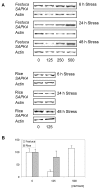
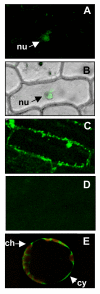
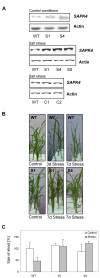
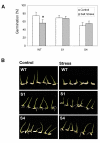
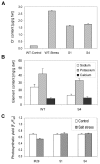
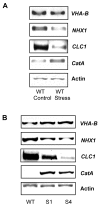

Similar articles
-
TaSnRK2.4, an SNF1-type serine/threonine protein kinase of wheat (Triticum aestivum L.), confers enhanced multistress tolerance in Arabidopsis.J Exp Bot. 2010 Mar;61(3):683-96. doi: 10.1093/jxb/erp331. Epub 2009 Dec 18. J Exp Bot. 2010. PMID: 20022921 Free PMC article.
-
An S-domain receptor-like kinase, OsSIK2, confers abiotic stress tolerance and delays dark-induced leaf senescence in rice.Plant Physiol. 2013 Dec;163(4):1752-65. doi: 10.1104/pp.113.224881. Epub 2013 Oct 18. Plant Physiol. 2013. PMID: 24143807 Free PMC article.
-
Expression of OsWNK9 in Arabidopsis conferred tolerance to salt and drought stress.Plant Sci. 2018 May;270:58-71. doi: 10.1016/j.plantsci.2018.02.008. Epub 2018 Feb 12. Plant Sci. 2018. PMID: 29576087
-
How salt stress-responsive proteins regulate plant adaptation to saline conditions.Plant Mol Biol. 2022 Feb;108(3):175-224. doi: 10.1007/s11103-021-01232-x. Epub 2021 Dec 29. Plant Mol Biol. 2022. PMID: 34964081 Review.
-
Functional characterization of gibberellin-regulated genes in rice using microarray system.Genomics Proteomics Bioinformatics. 2006 Aug;4(3):137-44. doi: 10.1016/S1672-0229(06)60026-0. Genomics Proteomics Bioinformatics. 2006. PMID: 17127211 Free PMC article. Review.
Cited by
-
Comparative proteomic analysis of early salt stress-responsive proteins in roots of SnRK2 transgenic rice.Proteome Sci. 2012 Mar 31;10:25. doi: 10.1186/1477-5956-10-25. Proteome Sci. 2012. PMID: 22462395 Free PMC article.
-
Transcriptome profiling of Gerbera hybrida reveals that stem bending is caused by water stress and regulation of abscisic acid.BMC Genomics. 2019 Jul 22;20(1):600. doi: 10.1186/s12864-019-5961-1. BMC Genomics. 2019. PMID: 31331262 Free PMC article.
-
Genome-Wide Analysis of Abscisic Acid Biosynthesis, Catabolism, and Signaling in Sorghum Bicolor under Saline-Alkali Stress.Biomolecules. 2019 Dec 3;9(12):823. doi: 10.3390/biom9120823. Biomolecules. 2019. PMID: 31817046 Free PMC article.
-
Comprehensive Analysis of SnRK Gene Family and their Responses to Salt Stress in Eucalyptus grandis.Int J Mol Sci. 2019 Jun 6;20(11):2786. doi: 10.3390/ijms20112786. Int J Mol Sci. 2019. PMID: 31174407 Free PMC article.
-
Recent Molecular Aspects and Integrated Omics Strategies for Understanding the Abiotic Stress Tolerance of Rice.Plants (Basel). 2023 May 18;12(10):2019. doi: 10.3390/plants12102019. Plants (Basel). 2023. PMID: 37653936 Free PMC article. Review.
References
-
- Sanz P. Snf1 protein kinase: a key player in the response to cellular stress in yeast. Biochemical Society Transactions. 2003;31:178–181. - PubMed
Publication types
MeSH terms
Substances
LinkOut - more resources
Full Text Sources
Molecular Biology Databases
Miscellaneous

